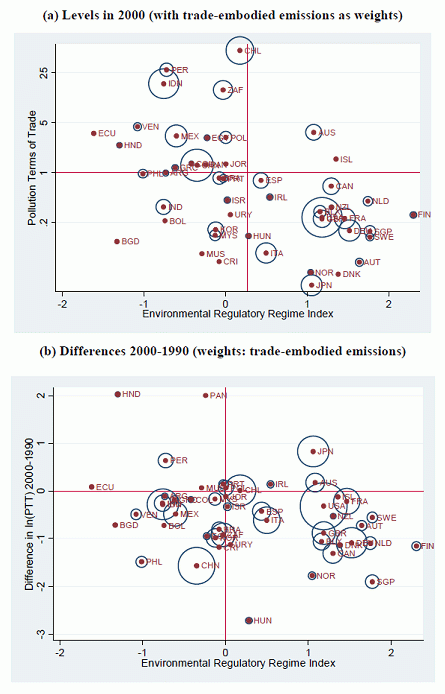For the environmentally minded, globalisation reflected in rising trade shares in world GDP is worrisome. Globalisation is a direct concern because the activity of trading itself generates pollution through the transport of goods (Hummels 2009 and Grether et al. 2010a), and an indirect concern because lower environmental standards generate a comparative advantage in "dirty" industries for developing countries (Antweiler et al 2001).
In this context, globalisation, which reduces transport costs and/or trade barriers, would shift investment and production of "dirty" goods to the South. As a result, globalisation would lead to an increase in the pollution content of imports by the North and to a worldwide increase in the production of dirty products – a theory known as the "pollution haven hypothesis". Likewise, the literature has emphasised that a tightening of environmental standards in the North would lead industries to relocate to the South according to what is referred to as the "pollution-haven effect". Making progress on the identification of the pollution-haven effect requires a comprehensive framework applied to many pollutants, many sectors and across many countries.
Correlation between the pollution terms of trade and environmental stringency
Relating an index of the pollution terms of trade – i.e. a country’s pollution content per unit of exports relative to its pollution content per unit of imports – to environmental regulation provides one perspective on the importance of pollution-haven effects. Following Antweiler (1996), two of us (Grether and Mathys 2010) have computed the pollution terms of trade for SO2 emissions taking into account direct and indirect emissions using input-output data. According to the pollution-haven hypothesis, in a period of trade liberalisation like the 1990s, “dirty” industries should tend to move to countries with lax environmental regulations. Figure 1 plots the pollution terms of trade against an index of Environmental Regulatory Regime (Esty and Porter 2001) where larger values indicate a more stringent environmental regulatory regime. Points in the upper left and bottom right quadrants correspond to specialisation patterns coherent with the pollution haven view. Results in Figure 1a are coherent with a pollution haven effect but the changes over the decade of the 1990s in Figure 1b do not confirm the pollution haven hypothesis as the scatter has many points in the upper right and bottom left quadrants.
Figure 1. Pollution terms of trade and environmental regulation
Determinants of the pollution content of trade
Differences in environmental regulation are however not the only factor influencing the pollution content of imports. If polluting industries are not only sensitive to environmental regulation but also capital intensive, they would tend to locate to the North because of its capital abundance (Copeland and Taylor 2003). Beside the widely known factor endowment effect, other “deep” factors including trade transactions costs should also be taken into account. Assuming these determinants enter multiplicatively, Grether et al. (2010b) carry out a systematic global estimation of the pollution content of bilateral trade across all industrial sectors for ten major pollutants (See the list in Figure 2). These estimates are then used to decompose the pollution content of imports into three components:
- a "deep" determinant component, (i.e. the import-embodied pollution that would occur for reasons unrelated to environmental policy and endowments, e.g. trade costs proxied by distance or market potential);
- a factor-endowment effect; and
- a pollution-haven effect.
Figure 2 normalises the “deep” component to 1 and adds the two other effects to get the total effect. A positive total effect indicates that pollution related factors (pollution-haven and factor-endowment effects) increase the pollution content of trade beyond the deep determinants.
Because of data limitations we assumed that for all pollutants (except for SO2 for which detailed emission coefficients were available), emissions per unit of labour are the same in all countries (see Aichele and Felbermayr 2010 for an application to the carbon content of trade).
Figure 2. Relative importance of pollution-haven and factor-endowment effects
Figure 2 shows very different decomposition patterns across pollutants. Support for the pollution-haven hypothesis holds for four pollutants: biological oxygen demand, SO2, total suspended particulates, and NO2. The effects for toxic metal pollution go in the opposite direction. This might be expected since toxic metal pollution is prevalent in heavy weight-reducing industries (iron and steel, non-ferrous metals) that are hardly mobile industries across countries (see Grether and de Melo 2004 for evidence of the lack of mobility of these industries).
Conclusions
Overall, these estimates suggest that the pollution haven effect represents a rather small contribution to the overall pollution content of imports of world trade, notably because of composition factors usually not considered in the debate. Differences in factor endowments and environmental policies work in opposite directions, and taken together, they have only marginally affected the pollution content of world trade although, as expected, the effect has been stronger on North-South trade flows.
References
Aichele R. and G. Felbermayr (2010), “Kyoto and the carbon content of trade”, VoxEU.org, 4 February.
Antweiler W. (1996), “The pollution terms of trade”, Economic Systems Research, 8(4):361-365.
Antweiler, A, B Copeland and MS Taylor (2001), “Is Free Trade Good for the Environment?”, American Economic Review, 91:877-908.
Copeland, BR and MS Taylor (2003), Trade and the Environment: Theory and Evidence, Princeton University Press.
Esty D and M Porter (2001), “Ranking national environmental regulation and performance: a leading indicator for future competitiveness”, The Global Competitiveness Report 2001-2002, Oxford University Press.
Grether, J-M and J de Melo, (2004), "Globalisation and dirty industries: Do pollution havens matter?" in RE Baldwin and A Winters (eds.), Challenges to Globalisation: Analyzing the Economics, University of Chicago Press, 167-208.
Grether J-M and Nicole A Mathys (2010), “Measuring the pollution terms of trade with technique effects”, mimeo, University of Neuchâtel.
Grether, J-M, NA Mathys and J de Melo (2010a), "Global Manufacturing SO2 Emissions: Does Trade Matter”, Review of World Economics, 145(4):713-729.
Grether, J-M, NA Mathys and J de Melo (2010b), "Unravelling the worldwide pollution haven effect”, Journal of International Trade and Economic Development, iFirst:1-32





